计算机网络概论 英文版精品PPT课件
合集下载
计算机网络基础知识ppt课件 英文版
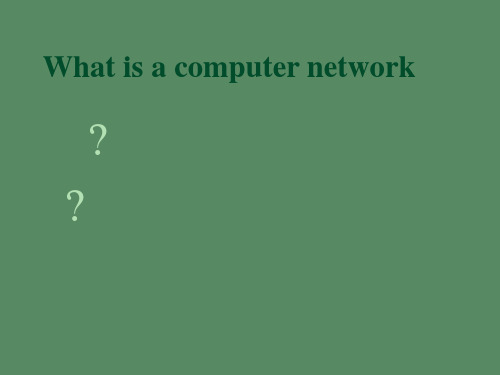
sketch map
Main function: to achieve the communication and resource sharing1. Basic function: data communication Main features: resource sharing
data
Classification: wide area network (WAN):Tens to thousands of kilometers local area network (ALN) A few meters to a few kilometers metropolitan area network(MAN) (Between WAN and LAN)
1.2
The basis of computertion -- in the form of an electrical signal to the data transmitted from one end to the other end. 2、 The m ai n technol ogy -- "t he maxi m um transmission rate index of data communication" 3、Modulation, demodulation (Modem): converting the data signals and analog signals.
批注本地保存成功开通会员云端永久保存去开通
What is a computer network
? ?
The computer network is the computer system in different geographical location and function of independent by communication lines are interconnected, the system realizes the sharing and communication of cyber source in the network management software
计算机网络英文教材ppt第二章

Chapter 2 The Physical Layer
30
2.5.3 The Local Loop: Modems, ADSL, and Wireless
Figure 2-23. The use of both analog and digital transmission for a computer to computer call. Conversion is done by the modems and codecs.
3
Chapter 2 The Physical Layer
DTE
DCE
传输介质 DCE
DTE
用户环境
通信系统
Chapter 2 The Physical Layer
用户环境
4
Chapter 2 The Physical Layer
DTE: Equipment that hopes to connect the network. Such as computer, terminal, etc.
2
Chapter 2 The Physical Layer
The definition of physical layer:
the interface between DTE(Data
Terminal Equipment) and
DCE(Data Communications
Equipment)
Chapter 2 The Physical Layer
Chapter 2 The Physical Layer
27
2.5.1 Structure of the Telephone System
(a) Fully-interconnected network. (b) Centralized switch. (c) Two-level hierarchy.
计算机网络英文课件Chapter1
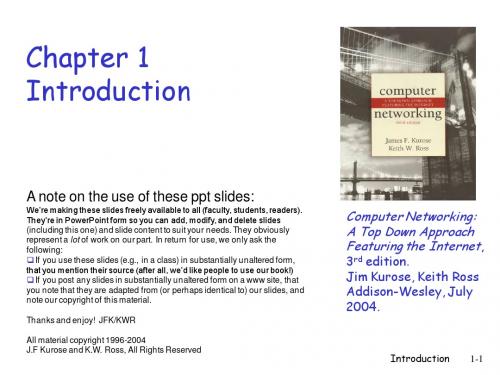
Introduction 1-11
client/server model
r r
peer-peer model:
r r
Network edge: connection-oriented service
Goal: data transfer
between end systems handshaking: setup (prepare for) data transfer ahead of time
Introduction 1-2
Chapter 1: roadmap
1.1 What is the Internet? 1.2 Network edge 1.3 Network core 1.4 Network access and physical media 1.5 Internet structure and ISPs 1.6 Delay & loss in packet-switched networks 1.7 Protocol layers, service models 1.8 History
protocols control sending,
receiving of msgs
r
router server local ISP
workstation mobile
e.g., TCP, IP, HTTP, FTP, PPP
Internet: “network of
networks”
r r
loosely hierarchical public Internet versus private intranet RFC: Request for comments IETF: Internet Engineering Task Force
client/server model
r r
peer-peer model:
r r
Network edge: connection-oriented service
Goal: data transfer
between end systems handshaking: setup (prepare for) data transfer ahead of time
Introduction 1-2
Chapter 1: roadmap
1.1 What is the Internet? 1.2 Network edge 1.3 Network core 1.4 Network access and physical media 1.5 Internet structure and ISPs 1.6 Delay & loss in packet-switched networks 1.7 Protocol layers, service models 1.8 History
protocols control sending,
receiving of msgs
r
router server local ISP
workstation mobile
e.g., TCP, IP, HTTP, FTP, PPP
Internet: “network of
networks”
r r
loosely hierarchical public Internet versus private intranet RFC: Request for comments IETF: Internet Engineering Task Force
计算机网络英文版课件1
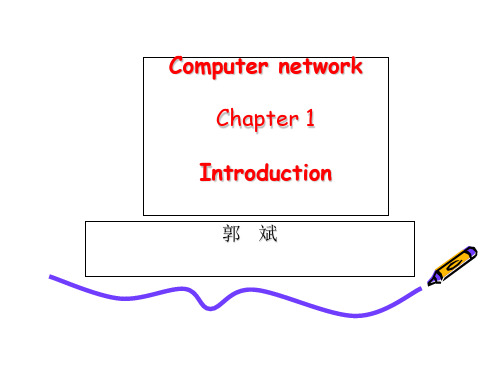
Development of computer network
T
T
HOST
T
T
T
T
T
HOST
TTT
T
T
HOST CCP
T
T
H
T
T
C
CCP
T
HOST
T
T
CCP
C CommunicaCt
T
HOST
T T
ion subnet
H
H
T
T
T
T
Resource subnet
T
computer network vs. distributed system
Wide Area Networks(2)
❖A stream of packets from sender to receiver. ❖Store-and-forward (packet-switched): a packet
is stored in an intermediate router in its entirety, stored there until the required output line is free, and then forwarded.
❖ Software: This is what actually makes computer networks–not the hardware!
➢ Protocols: describe how two communicating parties exchange
information.
➢ Services: describe what a network offers to parties that want
计算机网络概论 英文版
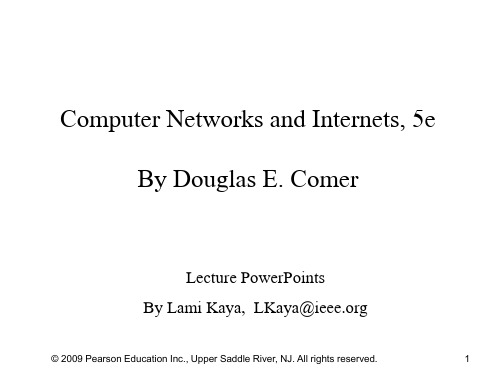
• • • • • • Stream denotes a paradigm in which a sequence of bytes flows from one application program to another Internet's mechanism arranges two streams between a pair of communicating applications, one in each direction The network accepts input from either application, and delivers the data to the other application The stream mechanism transfers a sequence of bytes without attaching meaning to the bytes and without inserting boundaries A sending application can choose to generate one byte at a time, or can generate blocks of bytes The network chooses the number of bytes to deliver at any time
– However, understanding network protocols and technologies allows them to write efficient and reliable code that enables applications to scale across many sites
© 2009 Pearson Education Inc., Upper Saddle River, NJ. All rights reserved. 9
– However, understanding network protocols and technologies allows them to write efficient and reliable code that enables applications to scale across many sites
© 2009 Pearson Education Inc., Upper Saddle River, NJ. All rights reserved. 9
计算机网络原理英文版课件Chapter3
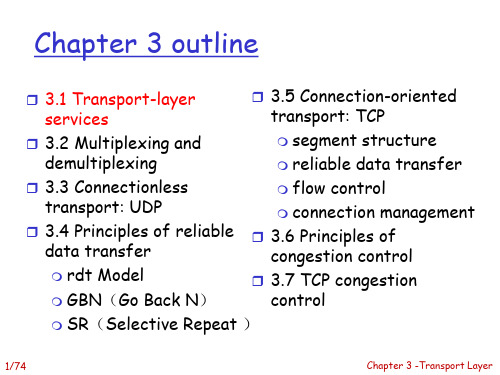
SP: 5775
DP: 80
D-IP:C
S-IP: B
Web Server Thread/subprocess
Chapter 3 outline
3.1 Transport-layer services 3.2 Multiplexing and demultiplexing 3.3 Connectionless transport: UDP 3.4 Principles of reliable data transfer rdt Model GBN(Go Back N) SR(Selective Repeat )
UDP: User Datagram Protocol [RFC 768]
“best effort” service, UDP segments may be: lost delivered out of order to app connectionless: no handshaking between UDP sender, receiver each UDP segment handled independently of others
Connectionless demux (cont)
DatagramSocket serverSocket = new DatagramSocket(6428);
Client IP:B
9157
P2
client IP: A
P1
5775
P1
6428
P3
server IP: C
SP: 6428
DP: 9157
Connection-oriented demux (cont)
Client IP:B
9157
DP: 80
D-IP:C
S-IP: B
Web Server Thread/subprocess
Chapter 3 outline
3.1 Transport-layer services 3.2 Multiplexing and demultiplexing 3.3 Connectionless transport: UDP 3.4 Principles of reliable data transfer rdt Model GBN(Go Back N) SR(Selective Repeat )
UDP: User Datagram Protocol [RFC 768]
“best effort” service, UDP segments may be: lost delivered out of order to app connectionless: no handshaking between UDP sender, receiver each UDP segment handled independently of others
Connectionless demux (cont)
DatagramSocket serverSocket = new DatagramSocket(6428);
Client IP:B
9157
P2
client IP: A
P1
5775
P1
6428
P3
server IP: C
SP: 6428
DP: 9157
Connection-oriented demux (cont)
Client IP:B
9157
计算机网络专业外语PPT

What is
the Computer Network Technically, Network is defined as "If at least one process in one computer is able to send/receive data to/from at least one process residing in a remote computer, then the two computers are said to be in network".
The Applications(应用 应用) 应用
A usenet newsgroup(新闻组) is
a repository usually within the Usenet system, for messages posted from many users in different locations. The term may be confusing to some, because it is usually a discussion group. Newsgroups are technically distinct from, but functionally similar to, discussion forums on the World Wide Web. News reader software is used to read newsgroups.
The Applications(应用 应用) 应用
---Video conferencing
The Applications(应用 应用) 应用
Voice over IP (VoIP网络电话) is a family of
计算机网络英文课件:1 Introduction
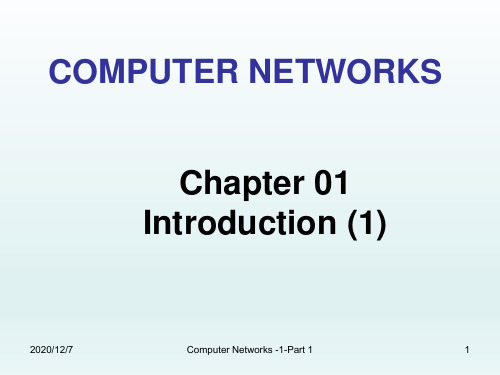
• new national networks: Csnet, BITnet, NSFnet, Minitel
• 100,000 hosts connected to confederation of networks
2020/12/7
Computer Networks -1-Part 1
5
Internet History
network for advanced research project agent of defense department, USA. • Internet: 1986 • National Information Infrastructure: 1993 • Commercialized Internet: 1995 • NGI: 1995, next generation internet • I2: 1996, Internet2 • CNGI: Cernet2 + …
– decentralized control define today’s Internet
architecture
2020/12/7
Computer Networks -1-Part 1
4
Internet History
1980-1990: new protocols, a proliferation of networks
• early 1990s: Web
– hypertext [Bush 1945, Nelson 1960’s]
– HTML, HTTP: Berners-Lee
– 1994: Mosaic, later Netscape – late 1990’s: commercialization
计算机网络英文版课件-第2章 The Physical Layer

• To computer scientists, (digital) bandwidth is the maximum data rate of a channel, a quantity measured in bits/sec.
Amplitude Amplitude
••• Time
f
3f
9f
Frequency
b. Frequency-domain decomposition of the composite signal
Computer Networks, Chapter 2 The Physical Layer
18
Time and frequency domain of a nonperiodic composite signal
Computer Networks, Chapter 2 The Physical Layer
6
Units of period and frequency
Computer Networks, Chapter 2 The Physical Layer
7
Simplex, half-duplex, or full-duTransmission
• The timing of a signal is unimportant. • Information is received and translated by agreed upon patterns.
Computer Networks, Chapter 2 The Physical Layer
Computer Networks, Chapter 2 The Physical Layer
3
Type of Data
Amplitude Amplitude
••• Time
f
3f
9f
Frequency
b. Frequency-domain decomposition of the composite signal
Computer Networks, Chapter 2 The Physical Layer
18
Time and frequency domain of a nonperiodic composite signal
Computer Networks, Chapter 2 The Physical Layer
6
Units of period and frequency
Computer Networks, Chapter 2 The Physical Layer
7
Simplex, half-duplex, or full-duTransmission
• The timing of a signal is unimportant. • Information is received and translated by agreed upon patterns.
Computer Networks, Chapter 2 The Physical Layer
Computer Networks, Chapter 2 The Physical Layer
3
Type of Data
计算机网络英文课件

wired links wireless links LANs
layer-2 packet is a frame, encapsulates datagram
data-link layer has responsibility of transferring datagrams from one node to adjacent node over a link
compute checksum of received segment check if computed checksum equals checksum field value:
NO - error detected YES - no error detected. But maybe errors nonetheless? More later ….
instantiation and implementation of various link layer technologies
Ethernet:broadcast channel PPP:point to point channel
chapter5-2
Link Layer Roadmap
chapter5-7
Full-duplex, Half-duplex, Simplex
Adapters Communicating
datagram sending node frame adapter link layer protocol frame adapter rcving node
link layer implemented in “adapter” (aka NIC)
计算机网络英文课件:1-2 Introduction

Computer Networks -1-Part 2
4
The Data Link Layer
• Data link layer is to transform a raw transmission facility into a line that appears free of undetected transmission errors to the network layer
Add a checksum (cyclic redundancy check) that should match the bits before it
Also: Provide the mechanisms so that fast senders don’t overwhelm slow receivers (flow control)
2020/12/7
Computer Networks -1-Part 2
5
Data Link Layer
• Observation: We also need to specify how a number of computers can share a common channel (e.g. wire), that is medium access control sublayer (MAC):
– How many nanoseconds a bit lasts
– whether transmission may proceed simultaneously in both directions
– how the initial connection is established
– how it is torn down when both sides are finished
计算机网络英文课件

Chapter 1: Computer Networks and the Internet
Resource sharing, high reliability, saving money Powerful communication medium(electronic mail, videoconference) e-commerce (electronic commerce)
Introduction and Overview
Uses of Computer Networks Mobile Users
Mobile computers, such as notebook computers and personal digital assistants (PDAs), are one of the fastest-growing segments of the computer industry. merger of cell phones and PDAs into tiny wireless computers, WAP (Wireless Application Protocol) portable office wireless networks on campus wireless networks on military Privacy Freedom of speech Copyright ……
Two computers are said to be interconnected if they are able to exchange information. The connection need not be via a copper wire; fiber optics, microwaves, infrared, and communication satellites can also be used. Networks come in many sizes, shapes and forms.
Resource sharing, high reliability, saving money Powerful communication medium(electronic mail, videoconference) e-commerce (electronic commerce)
Introduction and Overview
Uses of Computer Networks Mobile Users
Mobile computers, such as notebook computers and personal digital assistants (PDAs), are one of the fastest-growing segments of the computer industry. merger of cell phones and PDAs into tiny wireless computers, WAP (Wireless Application Protocol) portable office wireless networks on campus wireless networks on military Privacy Freedom of speech Copyright ……
Two computers are said to be interconnected if they are able to exchange information. The connection need not be via a copper wire; fiber optics, microwaves, infrared, and communication satellites can also be used. Networks come in many sizes, shapes and forms.
计算机网络第五版(英文版)ppt (6)
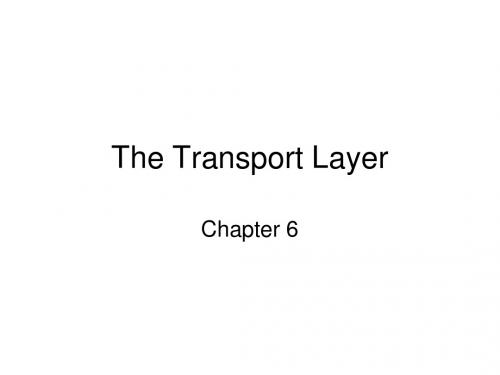
6.2.4 Error Control and Flow Control (1)
• Foundation for error control is a sliding window (from Link layer) with checksums and retransmissions • Flow control manages buffering at sender/receiver
6.2.2 Connection Establishment (2)
• Use a sequence number space large enough that it will not wrap, even when sending at full rate
– Clock (high bits) advances & keeps state over crash
a) Chained fixedsize buffers b) Chained variablesize buffers
c) One large circular buffer
• Flow control example: A’s data is limited by B’s buffer
B’s Buffer
6.2.2 Connection Establishment (1)
• Key problem is to ensure reliability even though packets may be lost, corrupted, delayed, and duplicated
– Don’t treat an old or duplicate packet as new – (Use ARQ and checksums for loss/corruption)
计算机网络双语课件第一章.ppt

company network
allows multiple communicating end systems to share a link, a switches, or
ISP(Internet Service Provider)
the whole path
chapter 1-6
What’s the Internet: “nuts and bolts” view
What’s a protocol?
human protocols:
“what’s the time?” “I have a question”
introductions
…there are specific msgs we send, and specific actions we take in response to the received reply msgs or other events
Route or Path
links and switches sequence that a
A
packet traversed from source to
destination
e.g., A->B the route is dynamic ,not dedicated
Packet switching
connection-oriented service
handshaking:
setup (prepare for) data transfer ahead of time
▪ send control packets to each other
▪ Hello, hello back human protocol
计算机网络英文教材ppt
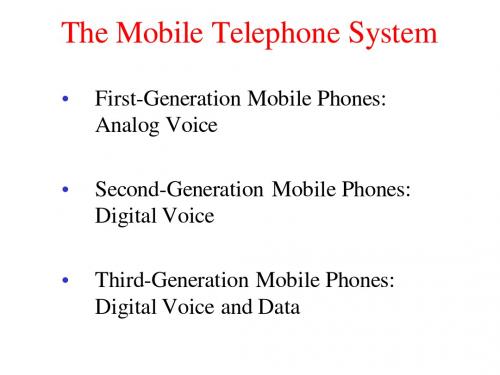
Cable Television
Community Antenna Television Internet over Cable Spectrum Allocation Cable Modems ADSL versus Cable
Community Antenna Television
Basic services an IMT-2000 network should provide High-quality voice transmission Messaging (replace e-mail, fax, SMS, chat, etc.) Multimedia (music, videos, films, TV, etc.) Internet access (web surfing, w/multimedia.)
The Mobile Telephone System
First-Generation Mobile Phones: Analog Voice Second-Generation Mobile Phones: Digital Voice Third-Generation Mobile Phones: Digital Voice and Data
An early cable television system.
Internet over Cable
Cable television
Internet over Cable (2)
The fixed telephone systFrequency allocation in a typical cable TV system used for Internet access
GSM uses 124 frequency channels, each of which uses an eight-slot TDM system
- 1、下载文档前请自行甄别文档内容的完整性,平台不提供额外的编辑、内容补充、找答案等附加服务。
- 2、"仅部分预览"的文档,不可在线预览部分如存在完整性等问题,可反馈申请退款(可完整预览的文档不适用该条件!)。
- 3、如文档侵犯您的权益,请联系客服反馈,我们会尽快为您处理(人工客服工作时间:9:00-18:30)。
1
Chapter 3
Internet Applications and
Network Programming
© 2009 Pearson Education Inc., Upper Saddle River, NJ. All rights reserved.
2
Topics Covered
• 3.1 Introduction • 3.2 Two Basic Internet Communication Paradigms • 3.3 Connection-Oriented Communication • 3.4 The Client-Server Model of Interaction • 3.5 Characteristics of Clients and Servers • 3.6 Server Programs and Server-Class Computers • 3.7 Requests, Responses, and Direction of Data Flow • 3.8 Multiple Clients and Multiple Servers • 3.9 Server Identification and Demultiplexing • 3.10 Concurrent Servers • 3.11 Circular Dependencies Among Servers • 3.12 Peer-to-Peer Interactions • 3.13 Network Programming and the Socket API
© 2009 Pearson Education Inc., Upper Saddle River, NJ. All rights reserved.
5
3.1 Introduction
• Internet application programmers can get started easily
© 2009 Pearson Education Inc., Upper Saddle River, NJ. All rights reserved.
3
Topics Covered
• 3.14 Sockets, Descriptors, and Network I/O • 3.15 Parameters and the Socket API • 3.16 Socket Calls in a Client and Server • 3.17 Socket Functions Used by Both Client and Server • 3.18 The Connection Function Used Only by a Client • 3.19 Socket Functions Used Only by a Server • 3.20 Socket Functions Used with the Message Paradigm • 3.21 Other Socket Functions • 3.22 Sockets, Threads, and Inheritance
– describes the conceptual paradigm that applications follow when they communicatesents the details of the socket Application Programming Interface (socket API) that Internet applications use
© 2009 Pearson Education Inc., Upper Saddle River, NJ. All rights reserved.
4
3.1 Introduction
• The Internet offers users a rich diversity of services
– none of the services is part of the underlying communication infrastructure
on computers attached to the Internet
• It is possible to devise new services without changing the Internet
• Chapter covers two key concepts of Internet applications:
Computer Networks and Internets, 5e By Douglas E. Comer
Lecture PowerPoints By Lami Kaya,
© 2009 Pearson Education Inc., Upper Saddle River, NJ. All rights reserved.
• It is possible to create Internet applications without knowing how networks operate
– However, understanding network protocols and technologies allows them to write efficient and reliable code that enables applications to scale across many sites
• Internet provides a general purpose mechanism on which
– all services are built – and individual services are supplied by application programs that run
• Later parts of the text provide the necessary information by explaining data communications and protocols used to form the Internet
